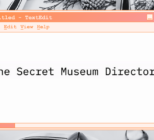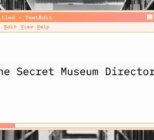The dictionary tells me that a museum is “an institution devoted to the procurement, care, study and display of objects of lasting interest or value.”
Funders tell me that my institution needs to engage more people with heritage and to change lives.
The current (at time of writing) Culture Secretary told me and several hundred others at an online Q&A a couple of weeks ago that the role of museums is to drive economic growth and increase employment levels.
My board tells me I need to save money; my team tells me that they need more money just to keep the wolf from the door.
It is a sea of people and money and stuff, where every so often something floats to the top, before sinking back down again, drowned by competing priorities and short-term wins.
Much as summer-season interactions with the general public might temporarily cloud my feelings, museums really are about people: being largely filled with the results of human curiosity, creativity and invention, how can they be about anything else? But the constant drive to increase our audiences and increase income is leaving other factors behind.
Where are bricks and mortar in all of this? Where do roofs and walls and staircases fit in for funders? I can get money by the bucket load for engagement projects and reinterpretation projects, but money to fix the decaying toilet block – unlovely, uninspiring; but vital – is in rather short supply.
Years of underfunding in routine maintenance has left us with an increasing backlog that is becoming harder and harder to fund. Much of it will have to moulder on, and be patched, before being swept up in the next panacea major capital project.
I can get money by the bucket load for engagement projects and reinterpretation projects, but money to fix the decaying toilet block - unlovely, uninspiring; but vital - is in rather short supply.
Knowledge and learning are in there somewhere; they’re definitely in our charitable objectives, which date from the time when there was a fundamental assumption that knowing more about the past, and understanding the patterns of history, will make us better people and improve our futures.
Is the assumption that knowledge builds empathy enough? We have all been working on the assumption that by showing people that ‘other people’ from a different time or different place are just like us would grow empathy and break down today’s intolerances. This is surely the underlying point of all the engagement funding and the audience-growing and all of the co-curation projects.
But as I watch the news and listen to statements from politicians and read comments on social media, it feels like more and more people are becoming ‘the others’ and that our worlds are narrowing, rather than expanding.
So, I ask myself: if I can’t fix leaking, decaying buildings, and if, despite all that we’ve been doing for so long, we can’t teach people that it is utterly unnecessary to be afraid of or cruel to others just because they are from a different place or background or lead a different life to us; what is the point?
More importantly, how do we continue in our work to break down barriers, when all around us they are growing higher and higher?











